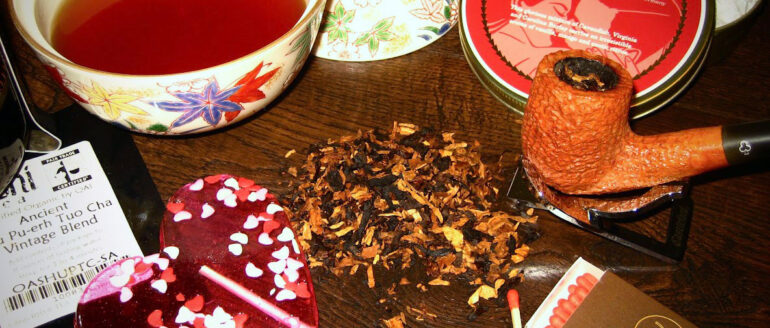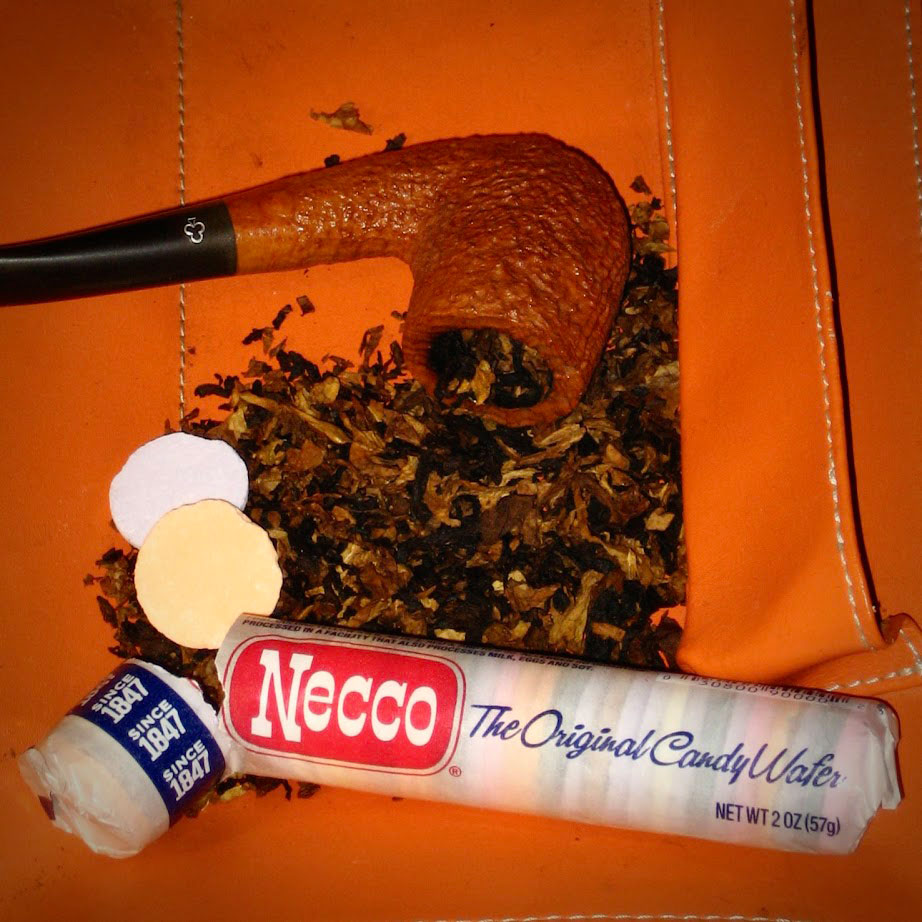
Guilty pleasures—we all have them; whether it’s bingeing the latest water-cooler television show, midnight-snacking entire pints of ice cream, or devoting hours to an online debate that we’re sure we’ve won. Us pipe snobs (face it, if you’re reading this article, you’re likely past the point of no return into the hobby) often catch flack—or give flack—for full aromatic blends, mistakenly thinking them the piper’s equivalent of a bike with training wheels, or confections for filthy casuals. A true pipe smoker, such prevailing wisdom may say, can only find enlightenment in the most mephitic of concoctions, the kernel of bodhi within which they have unlocked through years of trial and sacrifice, with wonderful tastes that they alone know how to perceive, naysayers be damned!
Well, that’s poppycock.
As the holidays came and went, I thoroughly enjoyed working my way through the tins of the aromatic C&D offerings reviewed in the last column, finding subtle little hints of new flavors here and there with every bowl full; I was particularly saddened when I went to re-order them and found them sold out; perhaps my guilty pleasure of being an unabashed aromatic smoker was not so singular as I had presumed? Such it was that I found myself pondering as I navigated the streets of the Financial District and popped in to Barclay-Rex, the City’s oldest family-run tobacconist—and indeed one of the few left of its ilk anywhere. Perusing through their offerings for new review material, my eye was drawn to the jazz-age graphic of a couple of flamenco dancers mid-embrace on a rose-colored tin of Ashton’s Guilty Pleasure, a no-pretense aromatic manufactured by Kohlhase & Kopp for the Ashton brand. Sure, there were English and cigar-leaf blends aplenty, various Virginias as far as the eye could see, but my holiday sweet tooth had not quite yet been fully sated.
“This glorious mixture of Cavendish, Virginia and Carolina burley carries an irresistible aroma of vanilla, mango, and exotic citrus,” reads the tin, promising an immodestly candied experience. Kohlhase & Kopp have produced many of my favorite aromatic blends, notably the erstwhile Peterson special editions, so I had great confidence that the tobacco would be of the best quality and not a waste of my time or money, as the price of tobacco in Manhattan is on the verge of requiring a bank loan. Popping the tin certainly confirmed this hypothesis; it unleashed a bright and floral confectionery sweetness that was sure to send the burliest he-man Latakiaphile running for the hills. The tobacco itself was that perfect melange of light-gold to dark-mahogany leaf of consistent cut that is a trademark of K&K blends in my experience. Parsing the aromas back in the laboratory, I kept searching for vanilla and mango—‘exotic citrus’ being indefinite enough to discount. Vanilla firmly chimes in as an overall binding aroma that the fruity notes couch themselves within, but I found mango or citrus aromas neither overt nor distinct in the blend; rather, they are verbal proxies for the overall sweetness and fruitiness with a decidedly floral bent of the bouquet; in fact the unique and unmistakable—though confoundingly unspecific—flavor of Necco wafers popped into my head as the best analog, a notion which would later prove to be shockingly precise. Even after weeks of an open-and-closed tin while sampling, the aroma remains quite strong and readily induces salivation.
Not to say that it’s done with too heavy or indelicate a hand—the tobaccos are clearly highest quality and allowed to shine through the mix to shape the smoke, which is quite a bit more restrained than the tin note would suggest. Puffing through a half-dozen bowls in search of the best instrument, I found the smoke then to be quite good and much more rounded than merely aromatic, if perhaps lacking a little in real depth, particularly held up against the last review blends mentioned. Bowl after bowl it presented quite brightly on top and faded to a good sweet nutty Cavendish-burley by mid-bowl, and tapered down slowly through to the heel—a heel that was easily reached with slow sipping and temperature control as well as a few rest periods and relights, and not goopy at all. Once I’d honed in on the proper pipe, cadence, and drink pairing, it was sweet heaven through the end of the tin. As for the room note, it is sweet but rather tame compared to the tin note; I would place both flavor and room note on the bright and fruity side of mild-to-medium.
While swapping out pipes to find a good mate for this blend I stumbled upon my cache of several years’ worth of Kaywoodie pipes from the holiday dinner and slow-smoke, to my good fortune. The straight billiards and clay cutty I started with weren’t really bringing out the full experience of the blend, tending to get too hot past top-bowl and not really hitting the mark on the aromatic notes while smoking. The delightful Shellcraft half-bent billiard pictured, handmade by Bill Feuerbach of very old-stock Algerian briar and vulcanite stem, nailed it like Mary Lou Retton on a floor routine—the perfect geometry of chamber to coax down a small ember, and the bend deep enough that the smoke could drift up to the nose easily for sidestream olfaction, all at barely an ounce of weight—as fine as any Dunhill in my collection, not to mention a repository of fond memories. There’s a lesson to be learned here: before finding just the right pipe, the blend would score below fair-to-middling; after, it was sweet euphoria.
Finding the best drink pairing for such a sweet blend proved challenging as well. Sometimes the notions come to me and I test them out to find they work perfectly, other times it’s down to a more Edisonian approach: determine the prevailing notes and alkalinity, then find drinks to congenially act as foils or amplifiers through brute force trial and error. In general it’s a good start to look for mildly acidic drinks, to balance out the tobacco—teas and coffees are obvious natural contrasts; but which teas or coffees? Earl Grey with a tart bergamot component spotlighted the nutty burley character but muted all else, while a 20-year-old Pu-erh was a bit too soft and not the counterpoint I’d anticipated, instead bringing out the woody and earthy spectrum to the detriment of the sweetness. On the coffee side, a short espresso tended to quash all but the aftertaste, and was much too small a serving to accompany a bowl that would last upwards of three quarters of an hour. I finally settled on an inexpensive Sumatra prepared pour-over and served black and hot as the best pairing: earthy truffle and mushroom notes provided good grounding for the sweet fruitiness of the smoke to perch on, the mild acidity effectively balanced out the tobacco’s pH so the smoke could commingle flavors on the tongue and palate effectively, and brewing twelve ounces at a time to a thermos provided an always-hot refresher to keep pace with a slow smoke.
Though my own paramour does not enjoy tobacco smoke, she does not begrudge me my little guilty pleasures. And pleasures indeed they are! The deconstruction of a blend, sampling of flavors, and search for the perfect pairings makes every tin an adventure which I hope to share with the reader as encouragement for their own peregrinations. As I’m still in the early acquaintance with this blend, I look forward to readers experienced with Guilty Pleasure offering their own recommendations for pairings in the comments.
Thanks to Barclay-Rex for hanging in there in NYC (and apologies for missing out on IPSD!), Economy Candy for being the best candy store in the world, and tune in next time for a continuation of jazz-age themes with the recently released SPC Virginia Jazz.















